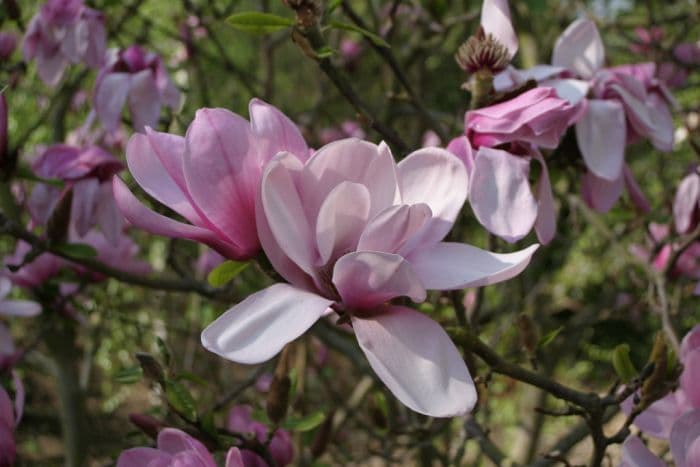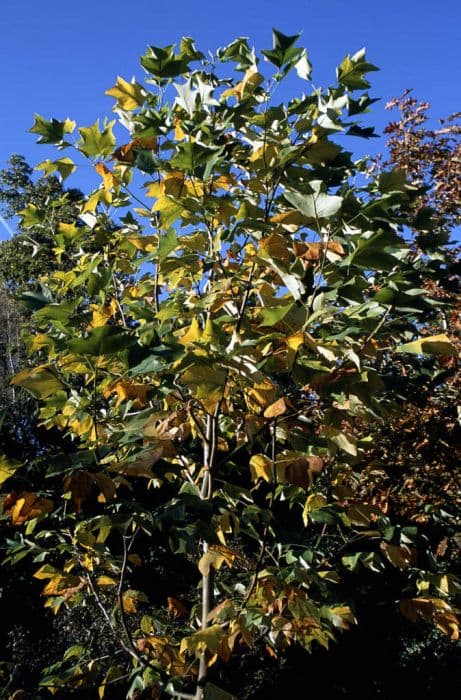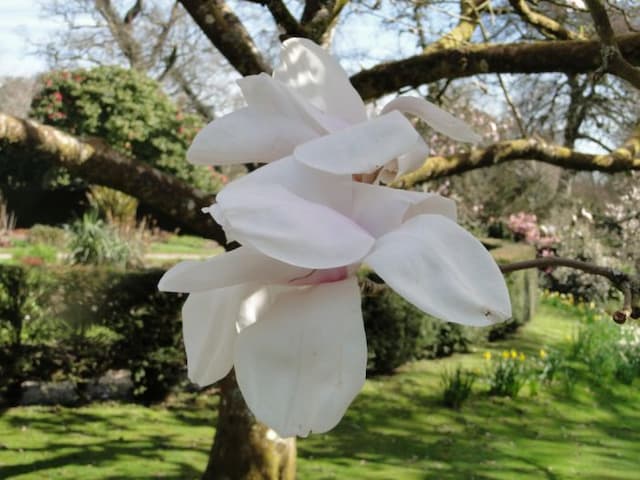Apollo Magnolia Magnolia 'Apollo'

ABOUT
Magnolia 'Apollo' is a stunning plant notable for its large, impressive flowers. The blooms are a mesmerizing deep purple-pink color, with a lighter pinkish-white hue on the inside, giving them a beautiful, two-toned effect. Each flower consists of a series of broad, thick petals that form a cup-like shape, often likened to tulips or goblets. The petals have a smooth, waxy texture, and as they unfurl, they release a delightful fragrance that adds to the appeal of the plant. The leaves of the Magnolia 'Apollo' are large and glossy, with a vibrant green color that provides a striking background to the showy flowers. They have an oval to oblong shape with a pointed tip and slightly wavy edges, providing a lush, robust foliage throughout the growing season. When the leaves are fully developed, they form a dense canopy that creates a sense of fullness and vitality. In the context of its overall appearance, the Magnolia 'Apollo' is celebrated for its visual impact in the garden, with the allure of its flowers often making it a focal point in spring when it is in bloom. The contrast of the dark pink-purple exterior of the petals with the lighter interior, along with its intoxicating scent, makes the plant a sensory treat. After the flowering period, the plant continues to hold interest with its attractive foliage.
About this plant
 Names
NamesFamily
Magnoliaceae
Synonyms
Apollo Magnolia
Common names
Magnolia 'Apollo'
 Toxicity
ToxicityTo humans
Magnolias, including Magnolia 'Apollo', are not commonly known to be toxic to humans. There is no widespread report of the magnolia causing serious poisoning or adverse reactions upon ingestion. However, as with any plant not typically intended for consumption, individual reactions can vary, and it is generally advised to avoid eating parts of ornamental plants.
To pets
Magnolias, including Magnolia 'Apollo', are also not known to be toxic to pets. They are generally considered to be of low toxicity to dogs and cats. Despite this, it is still possible for some pets to experience mild stomach upset if they ingest parts of the plant, as their digestive systems are not adapted to processing diverse plant materials. Signs may include vomiting or diarrhea, but serious toxicity is rare. It is always best to discourage pets from chewing on ornamental plants to avoid any potential problems.
 Characteristics
CharacteristicsLife cycle
Perennials
Foliage type
Deciduous
Color of leaves
Green
Flower color
Purple
Height
10 feet (3 meters)
Spread
6 feet (1.8 meters)
Plant type
Shrub
Hardiness zones
5
Native area
North America
Benefits
 General Benefits
General Benefits- Ornamental Beauty: Boasts large, fragrant, pinkish-purple flowers that add aesthetic value to landscapes.
- Attracts Pollinators: Flowers provide nectar for bees and other pollinating insects, supporting local ecosystems.
- Shade Provider: Can be used to create shaded areas in gardens due to its broad canopy.
- Seasonal Interest: Offers year-round interest with its flowers in spring, lush foliage in summer, and seed pods in autumn.
- Durability: Magnolias are known for their resistance to pests and diseases, making them a low-maintenance choice for gardeners.
 Medical Properties
Medical PropertiesThis plant is not used for medical purposes.
 Air-purifying Qualities
Air-purifying QualitiesThis plant is not specifically known for air purifying qualities.
 Other Uses
Other Uses- Magnolia 'Apollo' bark extract can be used as a natural dye for fabrics, providing a range of warm brown tones depending on the mordant used.
- The wood of the Magnolia 'Apollo' is moderately hard and can be used in woodworking for creating small objects like handles, ornaments, or inlays.
- Fallen magnolia petals can be pressed and used in crafting, such as making bookmarks, greeting cards, or pressed flower art.
- The leaves of the Magnolia 'Apollo' can be used as a natural mulch for garden beds, providing nutrients as they decompose.
- Due to its large leaves, the Magnolia 'Apollo' can act as a natural canopy or umbrella, offering shade for underplantings that require protection from direct sunlight.
- The seed pods of the Magnolia 'Apollo', once dried, can be used for decorative purposes in floral arrangements or as part of wreathes.
- Magnolia 'Apollo' branches can be used in their fresh form as a base for creating natural wreaths or other green decorative items.
- The flower petals of the Magnolia 'Apollo' can be candied and used as edible decorations for desserts or as a unique ingredient in gourmet dishes.
- During blooming season, the scented flowers of the Magnolia 'Apollo' can be used to infuse subtle floral notes into syrups or homemade potpourris.
- Magnolia 'Apollo' cones can be incorporated into homemade sensory play kits for children, providing a natural element to explore texture and shape.
Interesting Facts
 Feng Shui
Feng ShuiThe plant Magnolia is not used in Feng Shui practice.
 Zodiac Sign Compitability
Zodiac Sign CompitabilityThe plant Magnolia is not used in astrology practice.
 Plant Symbolism
Plant Symbolism- Nobility: The magnolia flower is often associated with nobility, conveying a sense of dignity and pride.
- Purity: With its pristine white petals, the magnolia symbolizes purity and innocence.
- Perseverance: Since magnolia trees are known for their hardy nature and longevity, they represent persistence and endurance.
- Beauty: The magnolia's striking appearance and impressive blooms are emblematic of splendid beauty.
- Love of Nature: As a plant often found in natural settings, the magnolia signifies a deep appreciation and love for the natural world.
 Water
WaterThe Magnolia 'Apollo', commonly known as 'Apollo' Magnolia, requires deep watering to ensure moisture reaches the roots, typically about once a week. However, during hot and dry periods, it may need additional watering. It's important to provide the 'Apollo' Magnolia with approximately 1.5 gallons of water per week but adjust this amount based on rainfall and soil drainage conditions. Over-watering or waterlogged soils should be avoided as they can lead to root issues.
 Light
LightThe 'Apollo' Magnolia thrives best in full sun to partial shade conditions. Planting it in a location that receives direct morning sunlight with some afternoon shade is ideal to protect it from the intense heat of the day.
 Temperature
TemperatureMagnolias 'Apollo' are suited to a range of temperature conditions but do best in an environment where temperatures are between 70°F and 85°F. They can survive temperatures as low as 10°F for short periods but frost can damage the flower buds and blooms. It is important to protect the 'Apollo' Magnolia from extreme cold below this range.
 Pruning
PruningPrune the 'Apollo' Magnolia in late winter or early spring before new growth starts to remove any dead or broken branches and maintain shape. It's not necessary to prune annually, but occasional thinning helps to encourage healthy growth and airflow. The best time for substantial pruning is after the tree has flowered if you want to avoid cutting off any buds.
 Cleaning
CleaningNot needed
 Soil
SoilMagnolia 'Apollo', commonly known as Magnolia, thrives in well-draining, slightly acidic to neutral soil with a pH range of 5.5 to 7.0. A good soil mix for this plant would consist of two parts loamy soil, one part peat moss, and one part compost or well-rotted manure to provide nutrients. Adding a layer of mulch can help retain soil moisture and regulate temperature.
 Repotting
RepottingMagnolias, including the Magnolia 'Apollo', do not need to be repotted frequently and can often thrive in the same pot for several years. However, if the pot becomes root-bound or the soil is exhausted, repotting can be done in the spring every 3 to 5 years with a fresh soil mix that is rich and well-draining.
 Humidity & Misting
Humidity & MistingMagnolias including Magnolia 'Apollo' prefer moderate humidity levels, ideally between 50-60%. They can adapt to the average outdoor humidity in most climates but should be protected from dry winds that can desiccate their foliage.
 Suitable locations
Suitable locationsIndoor
Provide bright, indirect light and monitor soil moisture.
Outdoor
Choose sunny to part-shady spot, shield from harsh winds.
Hardiness zone
5-9 USDA
 Life cycle
Life cycleThe Magnolia 'Apollo' begins its life when a seed germinates in a suitable environment, typically requiring well-drained soil and partial to full sunlight. After germination, the plant enters the seedling stage where it develops its first leaves and a root system. As it matures into the vegetative stage, the magnolia 'Apollo' grows rapidly and forms a woody stem, branches, and a larger root system. The plant then reaches the flowering stage, where it produces large, fragrant purple blossoms typically in early spring. Following pollination, the flowers develop into cone-like fruit that releases seeds, completing the reproductive cycle. Finally, the magnolia 'Apollo' enters a period of senescence in old age, with diminished growth and vigor, eventually leading to the plant's death.
 Propogation
PropogationPropogation time
Spring-Early Summer
The Magnolia 'Apollo' is best propagated by softwood cuttings taken in late spring or early summer when new growth is still flexible. To propagate, a gardener should select a healthy, non-flowering shoot and make a cutting approximately 4 to 6 inches (10 to 15 cm) long, cutting just below a leaf node. The lower leaves are removed, and the cut end dipped in rooting hormone for better rooting success. The cutting should then be placed in a well-draining potting mix, ensuring at least one node is beneath the soil surface as this is where roots will develop. The pot needs to be kept in a warm, humid environment with indirect light until roots have formed, which typically takes several weeks. Regularly checking the moisture level of the soil is critical to prevent the cutting from drying out or becoming waterlogged.








![Magnolia [Felix Jury]](/_next/image?url=https%3A%2F%2Fplants-admin.emdemapps.com%2Fimages%2Fplants%2F%2Fimages%2F604b61a0b23b7.png&w=640&q=75)
